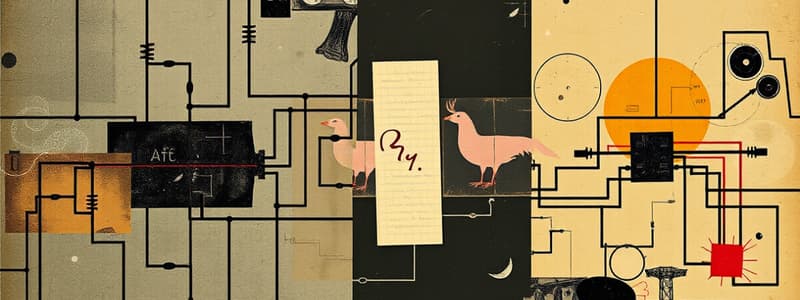Podcast
Questions and Answers
What does 'current' in an electric circuit refer to?
What does 'current' in an electric circuit refer to?
- The flow of electrical charge (correct)
- The resistance to the flow of electricity
- The pressure of electric charge
- The energy absorbed by a circuit
What is the SI unit for measuring current?
What is the SI unit for measuring current?
- Watt
- Ohm
- Ampere (correct)
- Volt
What is the correct definition of an electric circuit?
What is the correct definition of an electric circuit?
- A medium where charged particles are stored.
- A connection that only allows voltage to build up.
- An open path for energy transfer between objects.
- A path where electrons flow in a complete loop. (correct)
Which type of heat transfer occurs in gases and liquids?
Which type of heat transfer occurs in gases and liquids?
Which statement accurately describes Ohm's law?
Which statement accurately describes Ohm's law?
What does voltage represent in an electrical circuit?
What does voltage represent in an electrical circuit?
What happens to current when resistance increases while voltage is constant?
What happens to current when resistance increases while voltage is constant?
Which of the following best describes resistance in an electric circuit?
Which of the following best describes resistance in an electric circuit?
Which SI unit is designated for measuring resistance?
Which SI unit is designated for measuring resistance?
What does thermal energy consist of?
What does thermal energy consist of?
What is the primary mechanism of energy transfer between warmer and cooler objects?
What is the primary mechanism of energy transfer between warmer and cooler objects?
What type of heat transfer is characterized by direct contact between materials?
What type of heat transfer is characterized by direct contact between materials?
Which of the following statements is true regarding voltage?
Which of the following statements is true regarding voltage?
How does the Kinetic Molecular Theory relate temperature to molecular movement?
How does the Kinetic Molecular Theory relate temperature to molecular movement?
What describes the flow of electricity through a material?
What describes the flow of electricity through a material?
What is a key characteristic of resistive materials?
What is a key characteristic of resistive materials?
Flashcards are hidden until you start studying
Study Notes
Essential Elements of Electric Circuits
- Three key elements: Current, Resistance, Voltage (also known as potential difference).
- Current is measured in Amperes, symbolized as I, indicating the flow of electric charge in a conductor.
- Resistance refers to the opposition to the flow of electrons, measured in Ohms (Ω), named after Georg Simon Ohm.
- Voltage is the "push" that drives charges through a circuit, measured in Volts (V).
Heat and Temperature
- Heat transfers from higher to lower temperature objects, representing thermal energy.
- Temperature quantifies how hot or cold an object is, influencing molecular motion according to the Kinetic Molecular Theory.
Types of Heat Transfer
- Conduction: Energy transfer through direct contact between particles.
- Convection: Energy transfer in fluids (gases and liquids) via particle movement.
- Radiation: Energy transfer through electromagnetic waves, applicable in a vacuum.
Basic Electricity
- Electricity involves the flow of charged particles, primarily electrons, through a medium.
- Current is directly proportional to voltage and inversely proportional to resistance, as established by Ohm's law (V = IR).
- Higher voltage leads to greater current, while increased resistance results in lower current.
Characteristics of Electric Circuits
- An electric circuit is defined as a closed path that enables the flow of electric charges.
- Ohm's law describes the relationship between voltage, current, and resistance, illustrating how these elements interact within a circuit.
Studying That Suits You
Use AI to generate personalized quizzes and flashcards to suit your learning preferences.




